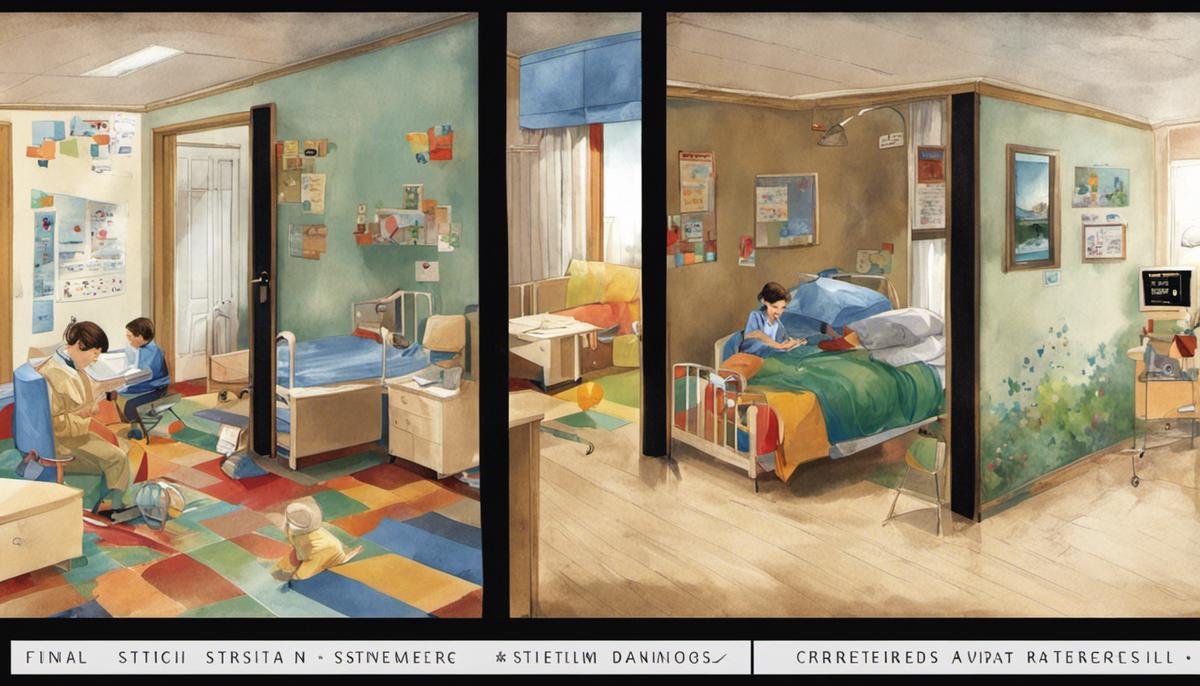
Autism Spectrum Disorder (ASD), a complex developmental condition that involves persistent challenges in social interaction, communication, and restricted/repetitive behaviors, is a topic that necessitates comprehensive understanding and support from society. It is critical for caregivers, teachers, therapists, and the general public to understand the intricacies of this condition, and be robustly prepared for the intricate journey that the ASD diagnostic process can often present. This will help enhance the detection process, be vigilant about potential issues in the diagnostic procedure, and ultimately equip individuals with Autism to surmount the hurdles and thrive in their unique ways.
Understanding Autism
Understanding Autism: Key Symptoms and Indicators
Autism Spectrum Disorder, commonly referred to as autism, might be a term we are familiar with, yet the essence of the condition remains misunderstood by many. Autism is a comprehensive neurodevelopmental disorder that affects communication and behavior. Seldom noticeable in infancy, autism generally emerges between 2-3 years of age. Instead of fearing it, let’s endeavor to understand it better.
Autism is a ‘spectrum’ because its symptoms can manifest differently for each individual, akin to varying hues in a rainbow. As a rainbow elicits happiness, imagine the potential if autism was equated with understanding and acceptance!
Let’s shape a more inclusive society by understanding the common symptoms of autism. This doesn’t aim to breed fear but rather to foster recognition and support. Remember, as differences are appreciated, the world becomes a more accommodating place.
- Communication Challenges: Children with autism might lag in language development or might not speak at all. They may often babble or use words in an unusual way. They might struggle to initiate or sustain a conversation.
- Social Interaction Difficulties: Autism often impairs the ability to interact and connect socially. Children might avoid eye contact or appear uninterested in others. They might struggle to understand other’s feelings or expressions and may exhibit difficulties with social cues.
- Repetitive Behavior: Look for repetitive movements, actions, or speech. This could include flapping hands, repeating words or phrases, or having an inflexible routine and showing distress at the slightest change. Interest is often restricted to certain topics or activities.
- Sensory Sensitivities: Many children with autism can be hyper-responsive or under-responsive to sensory inputs. They might react intensely to sounds, lights, or touch while seeming unresponsive to others.
- Developmental Delays: These could range from delays in motor coordination, cognitive skills, to play, and more.
If you notice several of these symptoms in a child, consider consulting a healthcare provider skilled in diagnosing autism. Early recognition and intervention can significantly improve the child’s development and quality of life.
Embracing the adage “Knowledge is Power,” let’s foster resilience, understanding, and acceptance of autism in our families and communities. It’s important to remember that while children with autism may experience life differently, they too have strengths, talents, and dreams, deserving of respect and inclusivity. Just as we enjoy the hues of a rainbow, let’s celebrate the uniqueness in every child. After all, it isn’t our similarities, but our differences that truly enrich our lives!

Autism Diagnostic Process
Steps Involved in the Autism Diagnosis
Sometimes, as parents, the journey to diagnose autism spectrum disorder (ASD) can seem overwhelming. While every child’s journey is different, it helps to know there’s a common pathway of steps that healthcare professionals carefully proceed through.
One of the first steps in the autism diagnosis process is an initial behavioral screening. This doesn’t provide a diagnosis, but it gauges a child’s behavior against standard developmental milestones. Screenings often occur during routine checkups. If results suggest the presence of ASD, the pediatrician typically will recommend more focused evaluations.
Following a positive initial screening, a comprehensive diagnostic evaluation will ensue. This often involves a team of specialists, including pediatric neurologists, psychologists, and speech and language pathologists. This team will conduct a thorough evaluation of the child’s behavior and development and may include genetic tests, neurological assessments, behavioral evaluations, and language tests.
Further, conducting a complete medical history and physical examination is another crucial step in the diagnosis process. This helps rule out other conditions that might cause similar symptoms, like hearing impairment or learning disorders. The family’s medical history can also reveal patterns of ASD or other developmental issues, bringing us closer to a more accurate diagnosis.
What’s more, assessments of a child’s communication, social interaction, behavior, and developmental level will be undertaken to make a final and accurate diagnosis. This interval can seem intimidating, but it’s essential to ensure an informed and correct diagnosis.
Lastly, autism is mostly diagnosed in childhood, typically around age 2 or 3, but can be detected as early as 18 months. There is no ‘right time’ for an autism diagnosis, yet an early identification can lead to more effective treatment and adaptation strategies.
Remember, having an early diagnosis doesn’t mean your little one won’t lead a fulfilled and joyful life. It merely provides a roadmap for you and your family specifically designed to ensure they acquire the leaning strategies and support needed.
Let’s step forward together in understanding ASD, and remember to consistently act as advocates for our children, offering them the necessary love and support they need to navigate their unique journey with autism. This way, we promote their immense potential and cultivate a more inclusive and understanding world, one step at a time.

Challenges in Diagnosis
Overcoming the Hurdles in Autism Diagnostics: A Closer Look
Autism diagnostic procedures can present quite a challenge for not only the medical fraternity but also the parents and caregivers of the individual. There’s an intricate labyrinth of factors behind this complexity. These hurdles once understood, can offer to facilitate an easier journey towards diagnosis and a more empowered life for the autistic individual.
Having a son or a daughter subjected to an autism diagnosis can feel overwhelming. Nonetheless, one needs to understand that the process involves a series of assessments that helps characterize a child’s unique strengths and challenges. The aim of this discussion is to shed light on these challenges faced in autism diagnostics and equip parents with knowledge, helping them take on this journey with confidence.
Autism diagnosis requires an evaluation of behavior, communication skills, and social interaction. These evaluations could paint a comprehensive picture but also present the challenge of variability. Autism, being a spectrum disorder, can manifest differently in every individual. A particular behavior could mean one thing in one child, and something else entirely in another. Therefore, achieving an accurate diagnosis can sometimes be like finding a needle in a haystack.
The timing of an autism diagnosis is another hurdle faced. Autism symptoms can sometimes present as early as 18 months but gaining a definitive diagnosis often happens much later, sometimes even into adulthood. This can be due to various reasons such as misdiagnosis due to the diverse and complex symptoms of autism or due to a lack of awareness and understanding of the disorder itself. Early diagnosis is vital to early intervention, which is why it’s so important to raise awareness and create accessible resources to accelerate this process.
Global healthcare systems should focus on promoting inclusivity by providing education and training for healthcare practitioners to understand and aptly identify the signs of autism. Comprehensive diagnostic assessments require a multi-disciplinary approach, involving professionals from a range of fields such as psychiatry, psychology, speech and language therapy, and occupational therapy. Balancing all these perspectives and ensuring clear communication between different branches can pose a significant logistical hurdle.
The role of parents and family members in autism diagnosis is pivotal. They provide the day-to-day insights and experiences of the child, which are often crucial in understanding the child’s behavior. While this not only puts a huge responsibility on their shoulders but also adds to their emotional turmoil, drafting a strong support system around them to guide them through the process would be instrumental.
Addressing these challenges is not just about improving diagnosis, but also about reaffirming the worth and potential of every child. Autism is not a deficiency, but a difference. Let’s spread the word, helping our society become more inclusive and understanding of autism. Together, we can facilitate a world where everyone, including those with autism, can thrive.

Post-Diagnosis Support
Unlocking A World Of Support Post-Autism Diagnosis
Learning that your child has been diagnosed with Autism Spectrum Disorder can be overwhelming. But knowing there’s a broad scope of support available can help ease the journey for both the child and the family.
Post-diagnosis, a child with autism isn’t left alone to navigate the world. There are numerous resources, both societal and structural, that provide the much-needed support. These include professional support services, specialized educational resources, local community services, and online communities – to name just a few.
Professional support is critical for managing autism. Psychiatrists, psychologists, speech-language pathologists, and occupational therapists are all part of the support network. Their invaluable guidance helps the individuals affected by autism to manage the symptoms, improve their communication abilities, and develop essential life skills.
Special educational resources, like individualized educational programs (IEPs), ensure the child remains on the academic path suitable for them. They help tailor the curriculum to suit the child’s unique strengths and motivations, facilitating a more effective learning experience. Additionally, special educators and teaching assistants play a vital role in making this possible, providing the much-needed educational scaffolding.
Local community services also chip in. They often organize fun and supportive activities, workshops, and programs specially designed for individuals with autism. These playgroups not only provide the child with richer experiences but also serve as social networking platforms for families, creating a tight-knit community where shared experiences become strengths.
Online resources are becoming increasingly popular and accessible. Websites, blogs, and social forums dedicated to autism connect families across the globe, creating a support system that transcends geographical boundaries. Advice, tips, stories of successes or failures – these communities offer a wealth of experience to lean on.
Funding routes are also available to lessen the financial burden that might accompany a diagnosis. These could include health insurance coverage, government-funded programs, non-profit grants, or local fundraising drives. Understanding these funding sources and their eligibility requirements can ensure the child receives all the help they’re entitled to.
Advocacy organizations play a significant role too. Their campaigns raise awareness, strive for policy changes, and foster a more inclusive society. By partnering with them, families can help widen the reach and impact of these efforts, benefitting not just their household but the entire autism community.
Remember, a diagnosis is the first step to understanding. Once this door is opened, a comprehensive support system awaits, ready to ensure your child achieves their fullest potential. Being proactive in seeking out this support system and immersing your family in it is crucial in navigating the journey that is living with autism.
Ultimately, an autism diagnosis is not an end, but a beginning – a journey in which the child, positively supported and encouraged, can grow to unlock their unique potential and live a fulfilled life. With the abundance of support available, having Autism Spectrum Disorder is about being different, not less, and those differences, beautifully embraced, can be the seed for greatness.

Living and Thriving with Autism
Navigating Life with Autism
Living and thriving with autism involves getting to know a new version of “normal” — often, a very unique, beautiful one. It demands a different perspective, innovative strategies, and plenty of patience. As a family, it’s about capitalizing on the strengths and learning to navigate around the challenges. Let’s dive into ways families can thrive while living with autism.
Foremost, to become an autism-friendly household, ensure every space is safe, stimulating, and comforting. Consider the sensory needs of your child — a quiet, calm space may be beneficial, or perhaps adding visual stimulants, like colorful posters or sensory mats, would be enriching.
Successful communication is critical too, and it’s not always through traditional methods. Alternative systems like picture exchange communication system (PECS), or using technology like tablets and communication software apps, can be effective. Maintaining eye contact can be difficult for children with autism; remember, this does not mean they’re not listening.
Routines are a lifesaver. Children with autism may thrive on regular schedules – wake up times, meal times, play times, bed times. Any changes should be introduced gradually, and visual schedules could be useful.
While routines are important, so too are social skills – and that involves socializing beyond your immediate family. It’s essential to gradually expose your child to different environments and social situations. This could mean play dates, family gatherings, or community events.
Transitioning between tasks and locations can be a hurdle. Visual timers, transition warnings, and explaining what’s happening next can help alleviate some of that stress.
Don’t do it alone. Join local autism groups for support, companionship, and sharing of resources. These groups provide emotional assist, help you stay up-to-date with recent research, and sometimes provide opportunities for supervised social interactions for your children.
Remember, with autism, it’s not about forcing a square peg into a round hole. It’s about creating a world where square holes exist too. Every milestone achieved, no matter how ‘small’, is cause for celebration. After all, it’s not comparing with others that matters, but celebrating progress no matter the pace.
Understanding the triggers, building around strengths and interests, focusing on the positives, and celebrating small victories can turn everyday challenges into fulfilling triumphs. Surrounding your child with love, encouraging their unique qualities, and cherishing all moments — it’s the way forward.
Moreover, as parents, never undermine your innate expertise. You will often know your child better than any specialist. Your input, observations, and the strategies that you have discovered are invaluable. Be involved, not only with the daily routines, but during professional interactions, therapies, and in advocating for your child’s needs at school and in the community.
Professionals will come and go in your child’s life, but you are the constant. They count on your love, your understanding, and your efforts to make their world better each day. Remember, this journey is not a sprint but a marathon. Celebrate the unique person your child is becoming and cherish the exceptional journey towards growth together as a family.
In the end, it’s about belonging, isn’t it? Everyone, including children with autism, needs to belong — to a family, to a neighborhood, to a community. And when we celebrate their successes, learn from their challenges, and navigate through this journey hand-in-hand, we not only teach them they belong but we also teach the world to accommodate, accept, and value the beautiful spectrum of human diversity. Because life with autism isn’t just about living, it’s about thriving, to the beat of a unique but beautiful drum.

Understanding the challenges and nuances of Autism Spectrum Disorder is not just critical for the individuals diagnosed with the condition, but also vital for the community at large. By facilitating an empathetic view and fostering inclusivity, we can ensure that individuals with Autism are equipped with the best tools and opportunities to express themselves, engage, and thrive in society. Through awareness, understanding and acceptance, we can create a world where the phrase ‘on the spectrum’ shifts from being a label to being just another beautiful shade in the diverse palette of human experience.




